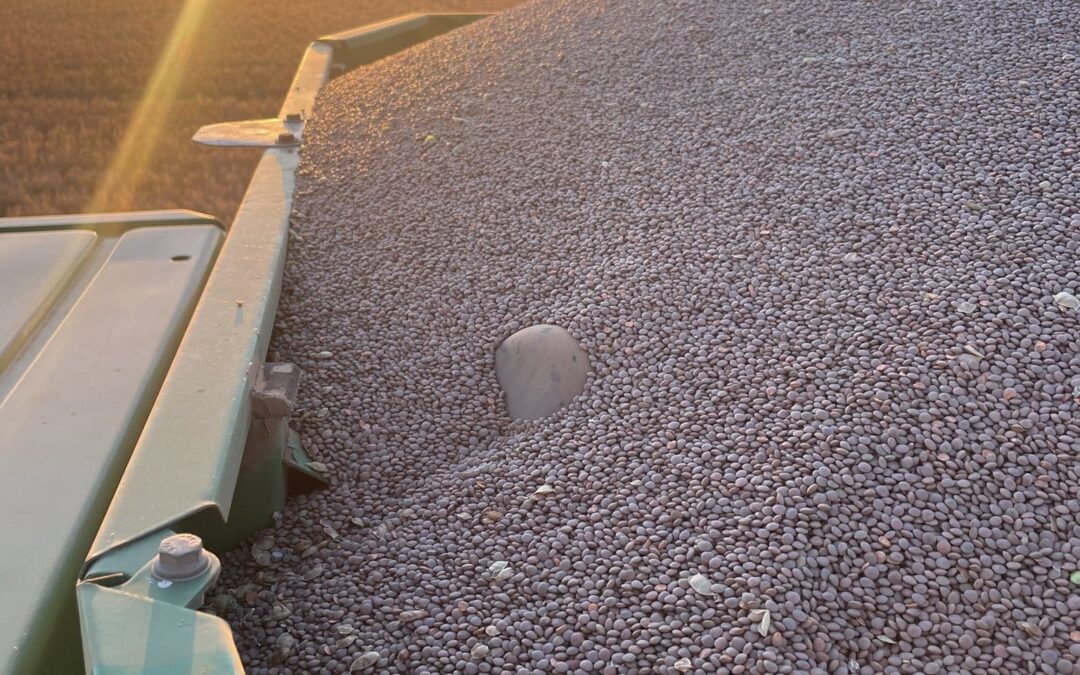AUSTRALIA’S winter pulse harvest is near its peak as headers roll into faba bean and lentil paddocks in south-eastern Australia.
With generally much lower yields being seen this harvest compared with last year’s bumper season, growers across Australia are selling pulses to generate cash flow.
This has put some supply-side pressure on lentils, but the market for faba beans has kicked on solid export and domestic buying, and export demand remains buoyant for the modest chickpea crop as harvest of the northern pulse nears its end.
Production prospects for mungbeans have improved markedly following soaking rain in some parts of Queensland and northern New South Wales in recent days.
On the research front, Dr Abeya Tefera is back from a trip to the US which has bolstered the interface between Agriculture Victoria’s pulse-breeding program and the use of AI.
Chickpeas
The Qld and NSW chickpea harvest is close to over, and while yields have been average or below, quality has been excellent.
Packers on southern Qld’s Darling Downs are paying around $870/t for new-crop CHKP1, down roughly $30/t since mid-October.
Shepherd Grain director Todd Jorgensen said the improved outlook for India’s rabi crop now being planted is largely behind the drop.
Last year’s rain-affected harvest saw widespread downgrading of chickpeas to CHKPX and CHKPM grades, but this year, quality is excellent and colour is bright as a result of the dry finish.
“This year, they look beautiful,” Mr Jorgensen said.
However, yields are as low as 1t/ha, well below the ABARES forecast average yield for the current harvest at 1.25t/ha, and 1.4t/ha estimated by ABARES for the 2022-23 harvest.
ABARES estimates the crop now being harvested at 533,000t, down from last season’s 541,000t crop.
Pakistan remains the volume destination, with Bangladesh also generating some bulk demand, and Middle East nations active on containerised product.
Faba beans
A dry end to the growing season has created smaller-than-normal seed in the Qld and central and northern NSW harvest, but quality is otherwise said to be good.
Both yields and seed size are expected to pick up as harvest moves into southern parts of NSW, Victoria and South Australia, where spring rain has pushed crops closer to their production potential.
Domestic stockfeed mills are paying around $480-$500/t delivered for faba beans to put into poultry and ruminant rations, while the delivered container terminal (DCT) market is trading at $540-$565/t.
Markets have risen by around $50/t in the past month.
“Quality is generally good; yield is the harder question,” Agri-Oz Exports managing director Francois Darcas said.
Rough early estimates put the Qld, NSW, SA and WA crops at 1.8-1.9t/ha, and closer to 2.5t/ha in Victoria’s Wimmera and SA’s South East.
In South Australia, AW Vater & Co principal Kim Vater said harvest of fabas was just starting in the Mid North, and his family business at Saddleworth received its first load for the season last week.
“When growers see prices move that quickly, from $460/t to $500 in a week, they think they might go higher.”
A number of mixed farmers and graziers who refused to sell sheep and lambs into the depressed September market are lot-feeding over the summer, which has increased domestic demand.
Mr Vater said frost may have clipped some yield potential from crops, as did a reasonably dry spring.
“They haven’t had the finish they did last year.”
ABARES forecasts the crop now being harvested at 447,000t from 267,000ha, down from 635,000t from 305,000t last season.
Lentils
Australia’s lentil harvest is at maximum pace this week in SA on the Yorke and Eyre peninsulas and Murray-Mallee, and in the Victorian Mallee.
Of Australia’s major lentil-growing regions, only the Wimmera is yet to start in earnest, and supply-side pressure appears to be weighing on price
Last week, lentils delivered port were trading at $930-$950/t, with larger types in the higher end, and down $50-$70/t from last month.
“A lot are going bulk, and we’re not 100pc full steam where we are, but most areas are,” Mr Vater said.
In the Mid North and Eyre Peninsula, frost appears to have affected yield and quality of some crops, but growers are generally expecting a solid performance from lentils.
ABARES is forecasting the current lentil harvest at 1.23 million tonnes (Mt) from 645,000ha, compared with a record 1.69Mt from 646,000ha produced last season.
Mungbeans
Nominal prices for new-crop mungbeans have lifted to $1250/t for processing-grade product, up $100/t on last month, with the product in strong demand from China and other destinations.
Australian Mungbean Association president James Hunt said talk that India will reopen to Australian product has made further price rises look likely.
“The best prices we’ve ever seen are when India and China are buying,” Mr Hunt said.
Qld and NSW produced a combined crop of around 55,000t this year, one of the smallest on record because of flooding at the start of the planting season and dry conditions at its end.
The industry is hoping the crop now being planted will produce at least double and maybe even triple that.
“NSW has generally some pretty good rain, and that’s given them the best chance for the sowing of mungbeans for the near future.
“The Downs is lacking a bit of moisture in places, but hopes are high rain will fill in the gaps.”
Mr Hunt said Downs growers who have had good rain were more likely to plant sorghum now and mungbeans closer to Christmas, while Central Qld will not plant until the second half of January.
Shepherd Grain’s Mr Jorgensen said the speedy pulse could well be the ideal fit in rotations in northern NSW this summer, where winter crops are the main game.
“There’s a number of farmers that hate planting sorghum when it will interfere with their winter cropping,” Mr Jorgensen said.
In recent days, parts of northern NSW have had significant rain, and registrations at Bureau of Meteorology gauges for the week to 9am today include: Gunnedah 38mm; Moree 51mm; Mungindi 45mm; Warialda 29mm; Wee Waa 38mm.
Qld registrations include: Dalby 53mm; Emerald 47mm; Oakey 55mm, and Springsure 45mm.
Some growers in southern Qld and northern NSW have recorded in excess of 100mm on their farm gauges.
As stockists of mungbean seed, Shepherd Grain is hoping to sell a considerable amount ahead of planting, ideally in the second half of January.
The business has also invested in the first mungbean-processing plant to be built in northern NSW in decades.
“It’s being commissioned now, and will be ready for the green beauties when they come in.”
The plant has been designed specifically to clean and grade mungbeans.
“What that means is it’s very good at getting the maximum yield to the grower.
“When cleaning, you do get some collateral damage, and what we’ve aimed for is the gentlest mungbean process to minimise that.”
Breeding gains from US trip
The pulse-breeding program at Agriculture Victoria’s Horsham Smart Farm is reaping the benefits from a researcher’s recent study trip to the US.

Dr Tefera at the US conference.
Agriculture Victoria molecular plant breeder Abeya Tefera attended a Genomic Prediction Breeding course at the University of Florida with a special focus on applied artificial intelligence (AI) followed by field visits to the University of Minnesota.
The course brought together scientists from the private sector and public organisations who are interested in learning more about different prediction frameworks and how to integrate layers of data for plant and animal breeding.
Dr Tefera formed ties with international peers for future collaboration and the skills he learnt have already helped inform new AI processes to study crop development and isolate climate-resilient lentil and field pea varieties.
“Our current advanced breeding strategies are already seeing rapid gains in genetic improvement and now with AI, we can incorporate additional data such as climate and crop development processes to selectively breed resilient traits into new varieties,” Dr Tefera said.
“Plants from our hi-tech glasshouses are photographed in the Plant Phenomics Victoria facilities at the SmartFarm and then we use Meta AI’s Segment Anything program to map varietal characteristics, such as boron toxicity and disease susceptibility.
“This can then be applied across thousands of lines within Horsham Smart Farm’s pulse-breeding program.
“Compared to manual methods, AI is making this process more accurate and speeds up the delivery of newer and more resistant varieties within our breeding program.”
Dr Tefera’s research is a co-investment between GRDC and Agriculture Victoria.

